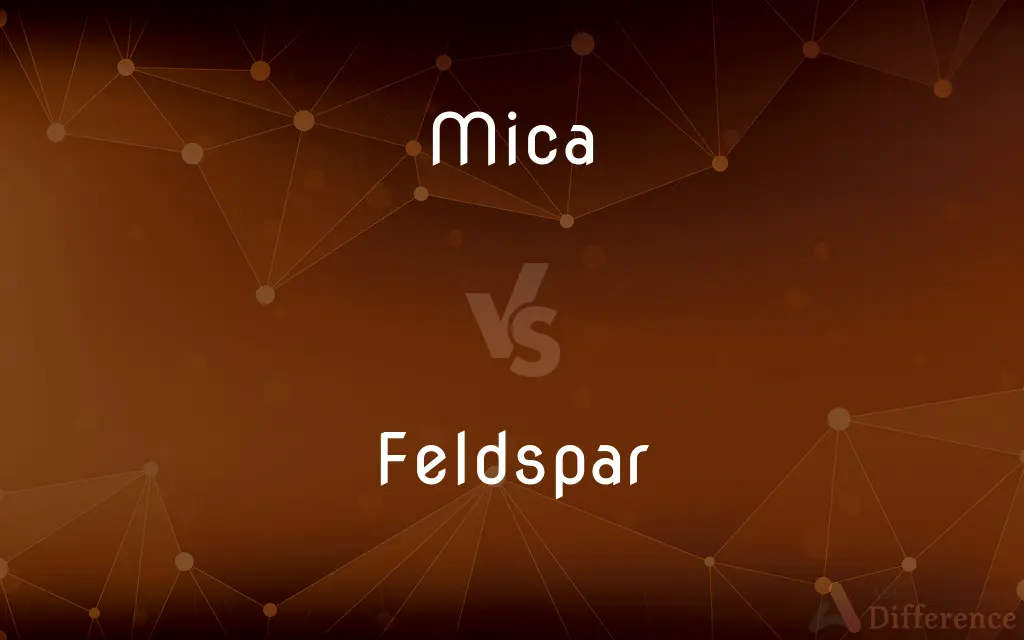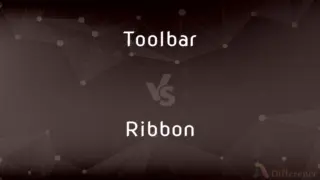Mica vs. Feldspar — What's the Difference?
By Maham Liaqat & Fiza Rafique — Updated on April 5, 2024
Mica is a mineral known for its perfect cleavage and shiny layers, whereas feldspar, the most abundant mineral group on Earth, stands out for its significance in rock formation and industrial uses.

Difference Between Mica and Feldspar
Table of Contents
ADVERTISEMENT
Key Differences
Mica is a group of minerals known for their ability to be split into thin, flexible sheets, thanks to their perfect cleavage. These sheets are highly reflective and range in color. On the other hand, feldspar encompasses a family of minerals that are primarily important for their extensive presence in the Earth's crust, forming more than half of terrestrial rocks.
While mica's physical properties, including its shiny appearance and elasticity, make it desirable for use in the cosmetic and electrical industries, feldspar's chemical composition, primarily silica and alumina, lends it a pivotal role in the manufacture of glass and ceramics.
Mica's thermal and electrical resistance allows it to function effectively as an insulator in electrical and electronic devices. Feldspar, however, contributes to the glass and ceramic industries by lowering melting temperatures and acting as a flux.
In terms of geological occurrence, mica minerals are typically found in igneous and metamorphic rocks, showcasing their formation under high-temperature conditions. Feldspar, while also prevalent in igneous rocks, distinguishes itself by its presence in sedimentary rocks, indicating its stability under various environmental conditions.
Despite both minerals being silicates, mica's structure allows it to cleave into thin sheets, a property not found in feldspar, which breaks along two planes at right angles, resulting in blocky crystal shapes.
ADVERTISEMENT
Comparison Chart
Composition
Silicate minerals with varying compositions
Silicate minerals primarily of silica and alumina
Uses
Electrical insulators, cosmetics, paints
Glass and ceramics manufacturing, fillers
Cleavage
Perfect, in thin sheets
Good, in two directions at right angles
Appearance
Shiny, can be split into thin flexible sheets
Opaque, often blocky or granular in appearance
Thermal & Electrical Properties
Resistant, making it suitable for insulation
Less resistant, not used for insulation
Compare with Definitions
Mica
Occurs in igneous and metamorphic rocks.
Large mica crystals are often found in pegmatite formations.
Feldspar
Forms in blocky crystals, not in sheets.
Feldspar crystals can be distinguished by their blocky shape.
Mica
Resistant to heat and electricity.
Mica is essential in manufacturing heat-resistant cables.
Feldspar
Not used for electrical insulation.
Unlike mica, feldspar is not used in electrical applications.
Mica
Reflective and used in cosmetics for shimmer.
Mica powder is a common ingredient in eyeshadow and highlighter.
Feldspar
Most abundant mineral group in the Earth's crust.
Feldspar minerals are key components of granite's composition.
Mica
Silicate mineral known for perfect cleavage.
The mica in the granite sparkled under the sunlight.
Feldspar
Crucial in the manufacture of glass and ceramics.
Feldspar is used as a flux in the ceramic industry to lower firing temperatures.
Mica
Forms in thin, flexible sheets.
Mica sheets are used in electrical appliances for insulation.
Feldspar
Stable in both igneous and sedimentary rocks.
Feldspar is a significant mineral in the composition of sandstone.
Mica
Micas ( MY-kəz) are a group of minerals whose outstanding physical characteristic is that individual mica crystals can easily be split into extremely thin elastic plates. This characteristic is described as perfect basal cleavage.
Feldspar
Feldspars are a group of rock-forming aluminium tectosilicate minerals, containing sodium, calcium, potassium or barium. The most common members of the feldspar group are the plagioclase (sodium-calcium) feldspars and the alkali (potassium-sodium) feldspars.
Mica
A shiny silicate mineral with a layered structure, found as minute scales in granite and other rocks, or as crystals. It is used as a thermal or electrical insulator.
Feldspar
Any of a group of abundant rock-forming minerals occurring in igneous, metamorphic, and sedimentary rocks, and consisting of silicates of aluminum with potassium, sodium, calcium, and, rarely barium. About 60 percent of the earth's outer crust is composed of feldspar.
Mica
Any of a group of chemically and physically related aluminum silicate minerals, common in igneous and metamorphic rocks, characteristically splitting into flexible sheets used in insulation and electrical equipment.
Feldspar
(mineral) Any of a large group of rock-forming minerals that, together, make up about 60% of the earth's outer crust. The feldspars are all aluminum silicates of the alkali metals sodium, potassium, calcium and barium. Feldspars are the principal constituents of igneous and plutonic rocks.
Mica
(mineral) Any of a group of hydrous aluminosilicate minerals characterized by highly perfect cleavage, so that they readily separate into very thin leaves, more or less elastic.
Feldspar
A name given to a group of minerals, closely related in crystalline form, and all silicates of alumina with either potash, soda, lime, or, in one case, baryta. They occur in crystals and crystalline masses, vitreous in luster, and breaking rather easily in two directions at right angles to each other, or nearly so. The colors are usually white or nearly white, flesh-red, bluish, or greenish.
Mica
The name of a group of minerals characterized by highly perfect cleavage, so that they readily separate into very thin leaves, more or less elastic. They differ widely in composition, and vary in color from pale brown or yellow to green or black. The transparent forms are used in lanterns, the doors of stoves, etc., being popularly called isinglass. Formerly called also cat-silver, and glimmer.
Feldspar
Any of a group of hard crystalline minerals that consist of aluminum silicates of potassium or sodium or calcium or barium
Mica
Any of various minerals consisting of hydrous silicates of aluminum or potassium etc. that crystallize in forms that allow perfect cleavage into very thin leaves; used as dielectrics because of their resistance to electricity
Common Curiosities
What is mica used for?
Mica is used in electrical insulation, cosmetics, and paints for its reflective and insulating properties.
What makes feldspar unique among minerals?
Feldspar's abundance and role in forming more than half of the Earth's crust make it unique and critically important in geology.
Can mica be found in sedimentary rocks?
While less common, mica can be found in sedimentary rocks, particularly those that have undergone some degree of metamorphism.
Why is mica valued in the cosmetics industry?
Its reflective properties give a shimmering effect, making it popular in products like eyeshadow and highlighter.
Is mica biodegradable or environmentally friendly?
Mica itself is a natural mineral and not harmful to the environment, but mining practices can have environmental impacts.
How does feldspar contribute to glass making?
Feldspar acts as a flux in glass making, lowering the melting temperature and making the process more efficient.
What types of rocks contain mica?
Mica is commonly found in igneous and metamorphic rocks.
What is the thermal resistance of mica?
Mica has high thermal resistance, making it suitable for use in high-temperature applications.
How do mica and feldspar differ in appearance?
Mica is known for its shiny layers and flexibility, while feldspar has a more blocky or granular appearance.
What is the chemical composition of feldspar?
Feldspar is primarily composed of silica and alumina with varying amounts of sodium, potassium, and calcium.
Can feldspar be used in electronics?
Due to its chemical properties, feldspar is not typically used in electronics.
What role does feldspar play in ceramics?
Feldspar acts as a flux, helping to form the glass phase in ceramics and improving the strength and durability of ceramic products.
Are there different types of mica?
Yes, there are several types of mica, including biotite, muscovite, and phlogopite, each with unique properties.
How does the presence of feldspar affect rock formation?
Feldspar contributes to the composition and formation of many igneous and sedimentary rocks, influencing their texture and properties.
How does the cleavage of feldspar differ from that of mica?
Feldspar cleaves in two directions at right angles, producing more blocky shapes, unlike mica's thin sheets.
Share Your Discovery

Previous Comparison
Toolbar vs. Ribbon
Next Comparison
Assurer vs. InsurerAuthor Spotlight
Written by
Maham LiaqatCo-written by
Fiza RafiqueFiza Rafique is a skilled content writer at AskDifference.com, where she meticulously refines and enhances written pieces. Drawing from her vast editorial expertise, Fiza ensures clarity, accuracy, and precision in every article. Passionate about language, she continually seeks to elevate the quality of content for readers worldwide.














































